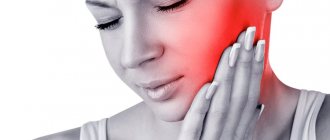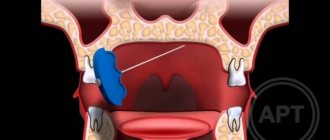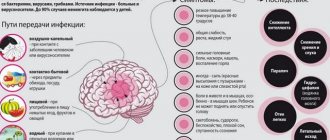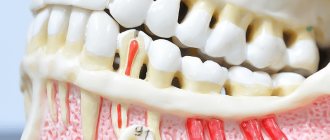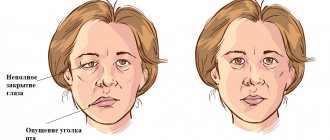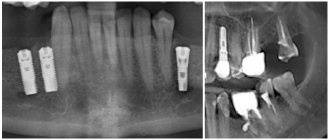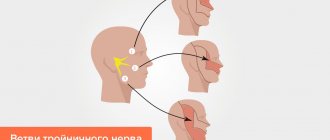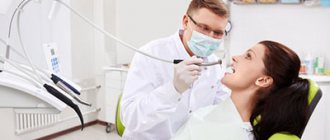Often you can meet people with an interesting facial expression: it is asymmetrical, as if distorted, emotionless, perhaps accompanied by small muscle twitches.
All these signs are united by a common name - facial neurosis. This condition can have a different nature of occurrence and is provoked by both objective reasons and factors of a psychogenic nature.
Unusual sensations
It happens that a person can feel phenomena in the face and head that are unusual for the usual state. They are called paresthesias and are manifested by the following symptoms:
- tingling;
- burning;
- "goosebumps"
- numbness;
- itching and rashes.
Often facial paresthesias have an organic basis and become a sign of the disease:
- neuritis, neuralgia of the cranial nerves;
- multiple sclerosis;
- stroke and other circulatory disorders in the brain;
- shingles;
- migraine;
- diabetes;
- epilepsy;
- hypertension.
In certain cases, unusual sensations are observed in certain parts of the face. For example, similar manifestations in the language may appear for the reasons listed above, but often have a different etiology. They are provoked by cancer of the tongue and larynx, as well as trauma by a splintered tooth or denture.
Dental procedures cause numbness and other unusual feelings, especially after tooth extraction. Another reason for their appearance may be an uncomfortable position during sleep or an unsuitable pillow. But the sensations caused by such phenomena usually pass soon.
Another group of provoking factors consists of psychogenic and neurogenic disorders.
Disorders of facial innervation
A neurotic face may develop due to damage to the nerves that innervate it. Most often these are the trigeminal and facial nerves.
The trigeminal nerve is the 5th pair of cranial nerves. It is the largest of all 12 pairs of these nerve fibers.
N. trigeminus arises symmetrically on both sides of the face and consists of 3 large branches: the ophthalmic, maxillary and mandibular nerves. These three large processes innervate a fairly large area:
- skin of the forehead and temples;
- mucous membrane of the oral and nasal cavities, sinuses;
- tongue, teeth, conjunctiva;
- muscles - chewing, floor of the mouth, palatine, tympanic membrane.
Accordingly, when it is damaged, pathological sensations arise in these elements.
Facial nerve – 7th pair of cranial nerves. Its branches surround the temporal and ocular region, the zygomatic arch, and descend to and behind the lower jaw. They innervate all facial muscles: auricular, orbicularis and zygomatic, chewing, upper lip and corners of the mouth, cheek. As well as the muscles of the lower lip and chin, around the mouth, the muscles of the nose and laughter, and the neck.
N. facialis is also paired, and is located on both sides of the face.
In 94% of cases, the damage to these nerve fibers is unilateral, and only 6% is a bilateral process.
Disruption of innervation can also be primary or secondary.
Primary is the lesion that initially involves the nerve. This could be hypothermia or strangulation.
Secondary damage develops as a consequence of other diseases.
Another reason for the development of facial neurosis is neurogenic and mental disorders. When unpleasant sensations in the face and head occur against the background of psycho-emotional arousal, shock, or as a result of stressful situations.
Causes of inflammatory damage to the trigeminal nerve
Factors contributing to inflammation of the trigeminal nerve are:
- surgical interventions on the jaw bones;
- fractures of the base of the skull, lower and upper jaws;
- tumors;
- complex tooth extraction;
- hypothermia;
- surgery on the maxillary sinus;
- improperly administered anesthesia;
- incorrectly performed dental prosthetics;
- metabolic disorders;
- the presence of foreign bodies that irritate the nerve trunk or injure nerve endings;
- bacterial or viral infection;
- various types of intoxication of the body;
- hypovitaminosis;
- weakening of the immune system.
Facial nerve neurosis
Neuritis (neurosis N. Facialis) or Bell's palsy occurs due to inflammation of the nerve fiber. Reasons leading to this condition:
- pinched nerve as a result of narrowing of the channel through which it passes. This may be a congenital phenomenon or result from inflammation;
- hypothermia;
- other diseases and infections: herpes, mumps, otitis media, stroke, cancer, central nervous system infections;
- injury N. Facialis.
The onset of the disease is usually gradual. Manifested by pain in the behind-the-ear area. After a couple of days, neurological facial symptoms appear:
- smoothing of the nasolabial fold, drooping of the corner of the mouth;
- the face becomes asymmetrical with a skew towards the healthy side;
- eyelids do not droop. When you try to do this, your eye rolls;
- any attempt to show at least some emotion ends in failure, since the patient cannot move his lips, smile, or manipulate his eyebrows. Such manifestations can worsen to the point of paresis and paralysis of the facial muscles, that is, to partial or complete immobility of the affected part of the face;
- taste sensitivity decreases, salivation appears;
- the eyes are dry, but there is lacrimation when eating;
- hearing on the affected side worsens.
The severity of pathological symptoms depends on the degree and area of damage to the nerve fiber. If the disease is treated inadequately, complications may arise in the form of muscle contractures (immobility).
Since the disease is inflammatory in nature, its treatment is aimed at eliminating it. For this, the patient is prescribed hormonal anti-inflammatory drugs - glucocorticoids, as well as decongestants.
Other methods include:
- prescription of vasodilators and analgesics, B vitamins;
- anticholinesterase agents to increase nerve conduction;
- drugs that improve metabolism in nervous tissue;
- physiotherapy;
- massage, exercise therapy in the recovery stage.
And only in extreme cases, when conservative therapy is ineffective, neurosurgical intervention is resorted to.
Symptoms
A common characteristic sign of the disease is immobilization and distortion of part of the face, in which it turns into a sedentary or completely motionless mask. Additional symptoms depend on where the inflammation occurs.
The facial nerve is a paired nerve; when it leaves the brain, it divides into two symmetrical branches. One of them is responsible for the innervation of the right side, and the other is responsible for the innervation of the left side of the face.
As a rule, inflammation affects only one of the two symmetrical parts, so the symptoms of neuritis are almost always unilateral. Contractions of the facial muscles become difficult or impossible, this manifests itself when trying to frown, smile, close an eye or raise an eyebrow. The face becomes distorted and asymmetrical.
The corner of the mouth and the edge of the eye are lowered, the nasolabial fold is smoothed out. When you try to close your eyelids, the eyeball turns upward (Bell's palsy). When you try to close your eyelids, a gap remains between them, this is called lagophthalmos or “hare's eye.”
Since the facial nerve consists primarily of motor fibers, inflammation of the facial nerve results in muscle symptoms. Sensitive, painful symptoms (in the form of neuralgia) are not typical for such neuritis.
However, the common nerve cord includes the intermedius nerve, which consists of sensory fibers and provides the sensation of taste to the outer two-thirds of the tongue, as well as the functioning of the salivary glands. Therefore, with neuritis of the facial nerve, symptoms such as disturbance, partial loss of taste, and increased salivation (drooling) are possible.
Another possible symptom is tear gland dysfunction, dry eye, or watery eyes. A combination of these two symptoms is possible - the so-called “crocodile tears”, when the eye becomes abundantly moisturized when eating, but remains dry the rest of the time (Bogorad syndrome).
Paresis or paralysis of the face usually develops within 24 hours after the appearance of pain behind the ear - the first sign of neuritis. As the disease progresses, symptoms such as hearing loss or intolerance to loud sounds (hyperacusis) are possible.
Ear pain with neuritis can radiate to the back of the head, temple, and be accompanied by loss of coordination, dizziness, and hearing loss. The complex of these symptoms is called Hunt syndrome.
Disruption of the innervation of the external eye muscle with neuritis of the facial nerve is manifested by convergent strabismus. Along with the characteristic signs of inflammatory damage to the facial nerve, symptoms of concomitant diseases may be observed, for example, shooting pain in the ear with otitis media. Or symptoms of cerebrovascular accident due to atherosclerosis.
From the point of view of Tibetan medicine, inflammation of the facial nerve, like other neuritis and neuropathies, refers to disorders of the governing basis Wind (Rlung - Tib.).
This is a light and cold base that has a great influence on other control systems of the body. Its disorder usually manifests itself not only with local symptoms (neuralgia, numbness, paresis, paralysis), but also with metabolic, immune, cardiovascular, respiratory, digestive, excretory, reproductive systems, as well as hormonal regulation.
Sanzhizhapova Avgustina Dondopovna Reflexologist, neurologist Experience 39 years
Trigeminal neuralgia
This is another lesion of the nerve fiber structure, which is often chronic and accompanied by periods of exacerbation and remission.
It has several causes, which are divided into idiopathic - when a nerve is pinched, and symptomatic.
The main symptom of neuralgia is paroxysmal sensations in the form of pain on the face and in the mouth.
Pain sensations have characteristic differences. They are “shooting” and resemble an electric shock; they arise in those parts that are innervated by the n.trigeminus. Having appeared once in one place, they do not change localization, but spread to other areas, each time following a clear, monotonous trajectory.
The nature of the pain is paroxysmal, lasting up to 2 minutes. At its height, a muscle tic is observed, that is, small twitching of the facial muscles. At this moment, the patient has a peculiar appearance: he seems to freeze, but does not cry, does not scream, and his face is not distorted from pain. He tries to make a minimum of movements, since any of them increases the pain. After the attack there is a period of calm.
Such a person performs the act of chewing only with the healthy side, at any time. Because of this, compaction or muscle atrophy develops in the affected area.
The symptoms of the disease are quite specific, and its diagnosis is not difficult.
Therapy for neuralgia begins with taking anticonvulsants, which form its basis. Their dose is subject to strict regulation and is prescribed according to a specific scheme. Representatives of this pharmacological group can reduce agitation and the degree of sensitivity to painful stimuli. And, therefore, reduce pain. Thanks to this, patients have the opportunity to freely eat and talk.
Physiotherapy is also used. If this treatment does not give the desired result, proceed to surgery.
Clinical picture
The symptoms are so characteristic that in a typical case the diagnosis is not difficult. The disease begins acutely, most often with pain behind the ear. Gradually the pain spreads across the face and to the back of the head. On the affected side, tears begin to flow from the eye, but sometimes dryness appears. Some patients notice that ordinary sounds have become extremely unpleasant. Over the course of 1-2 days, the symptoms increase, and paresis (weakness) or paralysis of the facial muscles occurs.
Manifestations of damage are:
- on the affected side of the face all skin folds are smoothed, this is especially visible on the nasolabial fold;
- when pronouncing consonants or at the moment of exhalation, swelling of the cheek is visible (symptom of “sail”);
- when you try to close your eyes, the eyelid on the affected side does not close, and the eyeball itself turns outward and upward - this characteristic symptom is called “hare’s eye” or lagophthalmos;
- When eating, solid food is between the gum and cheek, and liquid flows out of the corner of the mouth.
Real life examples
Some famous people, whose fame sometimes trumpets all over the world, were also hostage to the pathology of the facial nerve.
Sylvester Stallone, who is known for his enchanting roles, was injured at birth. The actor's mother had a difficult birth and he had to be pulled with forceps. The result is damage to the vocal cords and paresis of the left side of the face. Because of this, Stallone had problems with speech, which became a reason for ridicule from his peers.
The actor grew up as a difficult child. But, in spite of everything, he managed to overcome his defect and achieve considerable success, although partial immobility of his face remained.
Domestic showman Dmitry Nagiyev received facial asymmetry, which was nicknamed “Nagiyev’s squint”, due to paresis of the facial nerve. The illness happened unexpectedly. As a theater student, one day he felt that his face was not moving.
He spent 1.5 months in the hospital to no avail. But one day in his room a window broke due to a draft. Fright provoked a partial return of mobility and sensitivity of the facial part, but the left part retained its immobility.
Migraine
This condition is accompanied by attacks of unbearable headache. It is also associated with disruption of the trigeminal nerve, or more precisely, with its irritation in one part of the head. This is where the pain is subsequently localized.
The onset of migraine includes several stages:
- initial;
- aura;
- painful;
- final one.
Paresthesia of the head and face appears with the development of the aura stage. In this case, the patient is bothered by a feeling of tingling and crawling, which occurs in the arm and gradually moves to the neck and head. The person’s face becomes numb and it becomes difficult for him to speak. I am concerned about dizziness and visual disturbances in the form of light flashes, floaters and a decrease in the field of vision.
Facial paresthesia is a precursor to migraine, but often the attack occurs without the aura stage.
Treatment of neuritis of the maxillary trigeminal nerve
Therapy
The treatment program for trigeminal neuritis is drawn up taking into account the causes of the disease and its clinical signs. The main goals of treatment are:
- achieving a sensitizing effect;
- fight against bacterial and viral infection;
- increasing the body's immune forces;
- elimination of swelling of the nerve trunk;
- restoration of natural adaptive and compensatory reactions;
- normalization of the patency of nerve impulses.
Healing procedures
The set of procedures aimed at blocking the inflammatory process and eliminating all manifestations of neuritis includes:
- antibacterial therapy;
- antiviral therapy;
- elimination of factors contributing to the occurrence of intoxication;
- removal of tumor-like neoplasms or dissection of adhesions compressing the nerve;
- prescribing vitamin and mineral complexes to the patient;
- stimulation of nerves and muscles;
- acupuncture;
- physiotherapy (electrophoresis, phonophoresis, UHF, ultrasound, paraffin therapy).
People suffering from trigeminal neuritis are advised to regularly visit dental clinics and have their oral cavity sanitized.
Psychogenic causes of facial neurosis
Undoubtedly, disturbances in facial sensations quite often become a consequence of pathology of internal organs and blood vessels.
But often they are caused by psychological disorders and pathological thoughts that arise in our heads.
Facial paresthesias can be situational in nature and develop during episodic nervous excitement: as a result of quarrels, prolonged and intense screams. Such phenomena cause overstrain of the muscles, especially the cheeks and those located around the mouth. As a result, we experience facial numbness and even mild soreness.
The feeling of fear causes us to breathe quickly and shallowly, or to hold our breath. Disturbances in the respiratory rhythm can also provoke impressions that are atypical for us. A feeling arises that is characterized as a “chill running through.” Moreover, it is more concentrated at the roots of the hair. In this case they say: “chills to the marrow of the bones.” The face also becomes cold, a slight tingling appears in its area.
Such phenomena are disturbing when we are overwhelmed by strong emotions. But they accompany people suffering from mental disorders systematically.
A special type of neurotic facial manifestations is a nervous tic. It is characterized as an uncontrolled and systematic contraction of the facial muscles.
The disorder more often accompanies men. And it manifests itself with the following symptoms:
1.Motor:
- frequent blinking, winking;
- setting the lips with a tube;
- nodding head;
- constant spitting or sniffing;
- opening or upturning of the corner of the mouth;
- wrinkling of the nose.
2. Vocal:
- screaming;
- grunt;
- coughing;
- repetition of words.
There are also signs – precursors – that signal the appearance of a tic.
These include itching, facial heat and other paresthesias. Naturally, these signs are considered pathological if they occur in an inappropriate situation. It happens that only the patient himself feels them, but they are not visible to others.
But often twitching and other nervous symptoms become noticeable by other people, and they cause a lot of discomfort to the patient.
Tics can be simple, when there is only one symptom, or complex, which combines several manifestations.
The most common, main cause of tics is mental stress. It can be caused by a strong stress factor of one-stage action. Perhaps you were very scared of something, or broke up with your loved one. That is, the shock was so strong for you that your nervous system lost control.
Or, on the contrary, disorders develop as a result of prolonged monotonous exposure. Symptoms often appear due to lack of sleep and overwork.
Their duration varies. A situational nervous tic disappears a few hours or days after the cause is eliminated. In another case, it persists for years or haunts the patient throughout his life. In such a situation, in addition to eliminating the provoking factor, subsequent psychological work with the patient is required. This type of disorder is called chronic.
A nervous tic can be one of the signs of mental disorders such as neurosis, obsessive thoughts and phobias, depression.
Another group of provoking factors include:
- diseases - stroke, brain injury, infections or poisons;
- neurodegenerative diseases - Huntington's chorea. Characterized by destruction of brain tissue. Accompanied by uncoordinated, sudden movements, as well as neurological disorders of the face. Of these, the first sign is slow eye movements. Then a muscle spasm of the face occurs, which manifests itself in grotesque facial expressions - grimacing. Speech, chewing and swallowing are impaired;
- burdened heredity;
- parasitic infestations;
- eye fatigue due to prolonged eye strain;
- unbalanced diet, when the body receives little magnesium, calcium, glycine. These elements participate in the normal conduction of nerve impulses and are responsible for the coordinated functioning of the nervous system.
Nervous tics in children
There are several types of such disorders in childhood.
Transient tic disorder begins to manifest itself during early school age. Its duration ranges from 1 month to 1 year. Motor types of tics occur more often. Mainly typical for children with developmental delays and autism.
Chronic disorder occurs before age 18. And lasts from 1 year and above. In this case, either motor or vocal tics develop. The earlier the pathological symptoms appear, the easier and faster they pass.
Tourette syndrome is a multiple tic disorder characterized by both motor and movement types. A serious disease, which, however, softens with age.
A special type of disease, which is also characterized by signs of the nervous type, is minor chorea. It develops against the background of infections caused by streptococcus: sore throat, tonsillitis, rheumatism. Accompanied by pathological changes in nervous tissue.
Along with hyperkinesis, emotional instability, irritation, restlessness and anxiety, this condition corresponds to neurotic changes in the face. They are expressed in tension and spasms of the facial muscles, which is often mistaken for grimacing. There is also a spasm of the larynx, manifested in inappropriate screams.
At school, such children, not knowing the true cause of facial hyperkinesis, and even in combination with increased activity, are reprimanded and kicked out of class. Such an attitude towards the child forces him to miss school classes and avoid going to school. Treatment for chorea minor, along with sedatives, includes antibiotics to fight infection and anti-inflammatory drugs.
A nervous tic leaves a heavier imprint on a child’s psyche than on an adult. It often causes anxiety and detachment, withdrawal, and even provokes depressive disorders. Causes sleep disturbances, speech difficulties, and learning difficulties.
Tic disorders lead to distorted self-perception and decreased self-esteem.
Parents of such children are advised not to focus the child’s attention on the problem. On the contrary, they recommend finding ways to shift attention and increase self-esteem. A special place is given to support groups for such people and communication in general.
Facial nerve: treatment in children
Damage to the facial nerve in children is more common than damage to other cranial nerves, which is due to its anatomical features. The facial nerve is supplied with blood from the external carotid artery system, therefore, when the head is hypothermic, spasm of the external carotid artery leads to nerve ischemia, swelling and compression of the facial nerve. Compression of the facial nerve develops especially easily when the process is localized in the narrow canal of the temporal bone pyramid. The facial nerve canal is connected to the tympanic cavity and the pneumatic cells of the mastoid process. The outflow of lymph from the trunk of the facial nerve occurs in the cervical lymph nodes. In childhood, damage to the cervical lymph nodes is often observed.
How to get rid of nervous tics
In order to free yourself from unpleasant sensations, you must first eliminate their problem. Sometimes all it takes is a good night's sleep. In another case, you need to change the situation for a while, get out of the destructive environment.
Among the auxiliary methods used are herbal soothing teas, baths with the addition of aromatic oils, swimming, walks in the fresh air or sports: running, yoga.
Add ingredients with a high content of calcium and magnesium to your menu. These include fermented milk products, buckwheat, bran bread, red fish, eggs, and meat. Vegetables and fruits include beets, currants, dried fruits, nuts and parsley.
If these foods do not fit into your diet, consider taking appropriate vitamin supplements. Do not overuse strong tea and coffee.
And most importantly: remain optimistic and calm in any situation!
In cases where the condition worsens, psychotherapy is sought. Cognitive behavioral therapy is especially effective in helping to stop tic disorders at the stage of their precursors.
Habit reversal therapy teaches patients movements that help prevent the development of neurological facial symptoms.
Medications include anticonvulsants and muscle relaxants, Botox injections, and antidepressants.
If the above methods are ineffective in combating nervous tics, they turn to deep brain stimulation. A device is installed in the GM that controls electrical impulses.
How to remove teak yourself
If a nervous facial tic is situational and is not too intense, but at the same time obsessive, you can try to get rid of it using physical methods.
One way is to try to disrupt the pathological muscle rhythm by overexerting it. For example, if your eye twitches, try to close your eyes tightly.
It is possible to calm an overexcited muscle through a light massage. Or apply cold to it. The temperature difference will also help. Wash your face alternately with cold and warm water.
Treatment
There is no special treatment for facial nerve neuropathy and treatment is most often symptomatic.
Corticosteroids: Although corticosteroids have many side effects, they can be effective in reducing symptoms of facial neuropathy.
Antiviral drugs such as acyclovir (Zovirax) may be prescribed along with corticosteroids to promote rapid recovery.
Surgical Treatment Options: Patients with intractable facial nerve neuropathies may be treated with surgical treatments such as muscle transpositions, muscle transfers, or nerve transpositions to help restore facial muscle movement.
Facial care: Daily exercise of the facial muscles can cause an increase in the range of movement in the face. By practicing raising the affected eyebrow, opening the affected side of the mouth, smiling, voluntarily closing both eyes, etc. can help improve muscle coordination and elasticity and improve muscle response.
Improving dietary habits: reducing milk intake, increasing water intake and consuming foods rich in vitamin B (B1, B6 and B12) helps stimulate nerve regeneration.
Daily massage: It is necessary to carry out a daily facial massage; Protecting the face from wind and harsh sunlight is also one way to protect the nerve from further damage.
Controlling your blood sugar: Diabetic neuropathy may increase your chances of developing complications of facial neuropathy. Monitoring and maintaining blood sugar levels at normal levels also plays an important role in preventing the development of progressive facial palsy.
Treatment of the eye for neuropathy
Nerve palsy in the face can limit the movement of the eye muscle and can make it nearly impossible to close the eyes voluntarily. If the eye is left open for a long period of time, the cornea will dry out and this will lead to serious complications. To reduce the risk of further damage to the eye, artificial tears and moisturizing eye ointments may be used. Wearing dark glasses can also help shield your eyes from dirt particles. The patient can manually cover the eye gently with a finger or a small bandage to avoid damaging the eye in any way.
Although facial neuropathy affects nearly 40,000 people in the United States each year, it is a condition that can be treated if diagnosed early. If facial nerve palsy is detected at the earliest stage, complete recovery of the nerve can be expected. Additionally, by diagnosing tumors early, the condition can be completely cured by removing the tumor that is compressing the facial nerve.
Dermatillomania
Neurosis of the face and scalp can manifest itself in a behavioral disorder such as dermatillomania.
Its main manifestation is scratching the skin of the face and head, not because of itching, but because of dissatisfaction with its appearance. This also includes an obsessive zeal to squeeze out pimples, scratch off scabs, and pull out hair. Self-injurious actions cause a short-term feeling of pleasure, followed by feelings of shame, frustration, and dissatisfaction.
The face of such patients is covered with scars and scars due to constant trauma to the skin. This process is uncontrollable and can occur at any time of the day. But most often traumatic actions are carried out in front of a mirror.
Symptoms of the disorder also include the habit of biting the lips and mucous membranes of the cheeks. Patients are not deterred by the prospect of redness, bleeding, and scarring of the skin. They repeat the ritual day after day. It lasts from a few minutes to an hour.
Such actions can be provoked by feelings of fear, anxiety, and close examination of one’s skin because there is nothing to do.
Dermatillomania has been described as a state of addiction. It begins with concentrating on what the patient thinks is a skin defect. Gradually, attention is increasingly focused on this detail. A person begins to think that he is sick with something serious. This provokes irritability and nervousness in him, leading to obsessive actions.
The root cause of the disease is rooted in the psychological state of a person and lies in self-dissatisfaction, anger, feelings of shame and malice. Traumatic rituals are a way of punishment, self-flagellation.
Treatment of this pathology requires the intervention of a psychotherapist and a dermatologist.
The main method of treating addiction is psychotherapy, in particular cognitive behavioral therapy.
Yoga, physical exercise, relaxation procedures, as well as any hobby that absorbs a person and helps redirect attention will help reduce anxiety, distract and relax.
The help of a dermatologist is necessary to eliminate skin lesions in order to prevent infection and reduce the degree of dermatological defect.
Possible complications
If a person does not pay attention to the symptoms and simply takes analgesics to relieve attacks of pain, the condition may worsen.
Untreated inflammation can cause:
- loosening of teeth (molars and wisdom teeth);
- atrophy of the muscles with which chewing occurs;
- earlier appearance of wrinkles;
- inflammation of the mucous membrane of the organs of vision or cornea due to a failure in the production of moisturizing fluid;
- deterioration in the appearance of the skin due to lack of normal nutrition;
- madarosis, that is, loss of eyelashes and eyebrow hair.
In order not to encounter unpleasant complications, you need to take preventive measures, and if there are initial signs, do not postpone a visit to the doctor.
Neuroses
This is a large group of diseases, manifested primarily in psycho-emotional disorders, as well as malfunctions of the autonomic nervous system. They do not cause pathological disorders of the nervous tissue, but have a significant impact on the human psyche.
There are several types of disorders in which the symptoms are visible.
Muscular neurosis is manifested by muscle tension, spasm and convulsive twitching. Neurosis of the facial muscles makes itself felt with the following manifestations:
- nervous tic;
- lip tension, clenching;
- convulsive contraction, the face seemed to move;
- tingling, burning sensation;
- muscle pain;
- Tension of the neck muscles is manifested by a feeling of lack of air, a lump in the throat.
When we find ourselves in a stressful situation, our body produces stress hormones. They, among many other reactions, cause muscle tension. Now imagine, if we are exposed to chronic stress, what happens to our muscles, and specifically to the muscles of the face. Being systematically in hypertonicity, they overexert themselves. This is what causes their nervous twitching, spasms, and convulsions.
Another type of neurosis is skin. It causes paresthesias in the facial skin of the following type:
- severe itching, burning in the facial and scalp without clear localization;
- sensation as if something were touching the face. And it's terribly annoying;
- the appearance of red spots on the face and neck. Possible rash.
The causes of such phenomena are nervous and mental overstrain, chronic stress, sleep disturbances, as well as disruptions in hormonal regulation.
With neuroses associated with disruption of the autonomic nervous system, various manifestations may also occur. Malfunctions in the functioning of the vascular network occur, and a vascular neurotic disorder develops.
Vascular neurosis of the face is manifested by flaking and dryness, a feeling of tightness of the skin. She becomes pale, sometimes cyanotic, and her sensitivity worsens. In addition, sneezing appears, the nose is stuffy, the eyes become red and watery, the skin itches and itches. This indicates the development of vegetative-allergic reactions.


